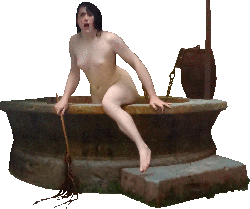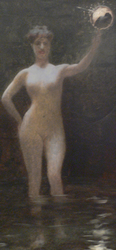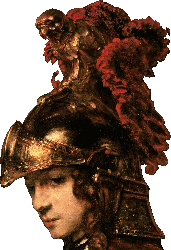TRUTH, LIES AND THE APATURIA

MYTHOS VS. LOGOS
Plato wrote of the ancient Athenians and their enemies from Atlantis in his Timaeus and Critias. These are the only primary sources for information about the infamous island empire: to date, all other references from antiquity which discuss Atlantis can either be shown to be reliant upon these dialogues or to discuss other subject matter.
Scholars recognise a dichotomy in ancient Greek attempts to describe historical and natural phenomena. The word μῦθος (muthos) - from whence comes our modern term "myth" - signifies a traditional story, most often with its roots in the oral tradition, whilst λόγος (lógos) - often regarded as its opposite - is used in the philosophical tradition to describe statements borne from observation and analysis. The two can be seen as representing the approaches of rationalisation and philosophy: William Wians, discussing Hesiod's Theogony, suggests this opus "often serves as a kind of no-man's-land between muthos and logos, usually being placed just short of the boundary where rationlizing myth gives way to philosophy."
Plato's original approach to his philosophical work, despite explicitly opposing them in Tim. 26e and the Phaedo - "a poet, if he is really to be a poet, must compose myths and not speeches (ποιεῖν μύθους ἀλλ᾽ οὐ λόγους)" [61b] - is an apparent attempt to "overcome the traditional opposition between muthos and lógos," and he makes use of a number of what have been characterised as myths during the course of his career, many of them based to a greater or lesser extent on traditional Greek beliefs.
The term lógos appears on fifteen occasions in the Critias and twenty times during the relevant earlier sections of the Timaeus. Plato's use of the lógos concept in the dialogues is striking and was used by ancient authorities and, more recently, has been cited as evidence by modern researchers that the Atlantis material may have had a factual origin.
This is, however, misleading. He also uses the term with regards to an origin story for an altar to Boreas in the Phaedrus [229ce], which, as it critiques euhemeristic interpretations of myth as allegorical explanations of natural phenomena, warrants quotation in full: -

In this instance, the lógos is presented as a deduction based on the facts as presented in the narrative of Boreas and Orithyia, though Socrates rejects the development of lógoi in this manner for the reasons cited.
Nevertheless, it is not impossible to see in Critias' speech a lógos attempting to explain, for example, the nature of the Atlantic ocean, which was believed by contemporary Greeks to be shallow and beset by shoals of mud, whilst also providing a morality tale about the sudden downfall of a hybristic power, couched within the parameters set by the prior speeches of Socrates about the ideal state and Timaeus on the origins of the universe and humanity [Tim. 27ab].
It is also well worth noting that Atlantis, in the far west, was located in the same liminal environment which also housed the "crowd of [...] creatures" and "multitudes of strange, inconceivable, portentous natures" cited in the Phaedrus.
Lógos, as part of the description eikōs lógos, is also used in a manner which has been suggested as an alternative for muthos in the title character's cosmogony in the Timaeus [30b, 48d, 53d, 55d, 90e; cf muthos at e.g. 29d].
There are also several occasions in the two dialogues where the account of the Athenians and Atlanteans is said to have been based upon a true (ἀληθῆ) story (retrospective quotes attributed to other speakers by the interlocutor Critias in the dialogue are marked in italics): -
| Location | Speaker | Translation | Context |
|---|---|---|---|
| Timaeus | |||
| 20d | Critias | Listen then, Socrates, to a tale which, though passing strange, is yet wholly true (παντάπασί γε μὴν ἀληθοῦς). | Critias introducing the story. |
| 21d | Amynander via Critias | Tell us from the beginning [...] what Solon related and how, and who were the informants who vouched for its truth (ἀληθῆ). | Critias describes how he heard this story from his grandfather. |
| 26e | Socrates | For this story will be admirably suited to the festival of the Goddess which is now being held, because of its connection with her; and the fact that it is no invented fable πλασθέντα μῦθον) but genuine history (ἀληθινὸν λόγον) is all-important. | Socrates approves of the tale as an elaboration on his Callipolis and as appropriate material for the Panathenaeum. |
| Critias | |||
| 109a | Critias | Now as regards the numerous barbaric tribes and all the Hellenic nations that then existed, the sequel of our story (λόγου), when it is, as it were, unrolled, will disclose what happened in each locality. | Possible introduction to the subject matter of the putative Hermocrates. Critias introduces the description of the two protagonists. |
| 110a | Critias | For legendary lore (λόγους) and the investigation of antiquity are visitants that come to cities in company with leisure, when they see that men are already furnished with the necessaries of life, and not before. [...] And for evidence of what I say I point to the statement of Solon, that the Egyptian priests, in describing the war of that period, mentioned most of those names—such as those of Cecrops and Erechtheus and Erichthonius and Erysichthon (λέγω δὲ αὐτὰ τεκμαιρόμενος ὅτι Κέκροπός τε καὶ Ἐρεχθέως καὶ Ἐριχθονίου καὶ Ἐρυσίχθονος). | Critias cites the use of the names of ancient Athenian potentates as evidence of veracity. |
| 111d | Critias | [T]he shrines which still remain even now, at the spots where the fountains formerly existed, are signs which testify that our present description of the land is true (ἀληθῆ). | There is archaeological evidence, in the form of ruined shrines, dating back to the time in question which is able to be cited as evidence. |
Of all of these occurrences of protestations of truth, the motherlode is Socrates' apparent stamp of approval in the Timaeus [26e]. Thomas Rosenmayer explains Socrates' apparent belief as follows: "[i]n fact, there is so much harping on the word truth, and the complications of the traditio, that the reader is soon convinced of the fact that he is about to listen to a pseudos; and he is willing to suspend his disbelief. Socrates certainly is."
In other words, methinks Critias doth protest too much.
Thomas Kjeller Johansen is of a similar opinion: -
Johansen then proceeds to explain how the tale could be seen as 'true' within the context of Plato's thinking: -
Additionally, throughout the passage in which Critias introduces the story [Crit. 107b-108d], there are indications that all may not be as clear-cut as he professes: affected modesty it may be, but Critias hardly seems especially confident of the account he's about to relate.
One key quote is that: "[t]he accounts given by [...] all [the speakers present] must be, of course, of the nature of imitations and representations" [107b]. He also expresses his reliance on memory and hopes that he has remembered the putative Solonic material accurately [108d] and protests that he must relate the account "on the spur of the moment" [107e].
Critias also explicitly seeks to couch the tale of Atlantis within Timaeus' speculative cosmology, with a simultaneous appeal to Socrates' highly-educated elites [Tim. 27ab].
As noted elsewhere, Kathryn A. Morgan characterises the Atlantis tale as a Platonic "noble lie," designed to act as a charter myth for a fourth century Athens reformed of its imperialist-commercial ambitions in the wake of the inevitable (perhaps even imminent) collapse of the Second Athenian Confederation in the mid-360s.
Johansen's ideas are certainly in accord with such a reading. To quote Rosenmayer again: "in fact he [i.e. Socrates] declares that such a story is ideally suited to the festival of the goddess whom they are celebrating today - the Panathenaea, in point of fact," adding pertinently: "but surely in our imagination this festival merges with that on which Critias heard the tale from his grandfather, the Apatouria; and that is, to use a popular etymology, the Festival of Deception."
FICTION DRESSED AS FACT: TIME-HONOURED
It is also worth noting that many fictions since Plato's time have sought to establish a level of believability.
According to Photius I of Constantinople's epitome of Antonius Diogenes' lengthy novel Τὰ ὑπὲρ Θoύλην ἄπιστα ("On the Wonders Beyond Thule"), this epic tale of a marvellous journey to the northern land of Thule was accompanied by a correspondence, with a Faustinus, who has himself discovered a letter written by a Greek, Balagrus, to his wife Phila (both of whom are historical figures from the time of Alexander the Great) which reveals the discovery of a hypogaeum containing a number of sarcophagi and a cypress box containing the testimony of two of the deceased, Deinias and Derkyllis, which ostensibly forms the basis of Antonius' novel.
Thule almost certainly has a basis in fact, being variously identified with several lands to the north of the island of Britain, as does Japan, which features in another, much later, work, the Anglo-Irish clergyman Jonathan Swift's Gulliver's Travels - a parody of the subset of travellers' tales from the Age of Exploration which focussed on the lurid and bizarre - in which the protagonist Lemuel Gulliver discovers a sequence of fantastic places and encounters their bizarre populations.
Gulliver's Travels too is prefaced by a correspondence involving the protagonist, Lemuel Gulliver, and his cousin Richard Sympson, who reports that the fictional Gulliver was regarded as a byword for veracity among his neighbours! Gulliver himself is made to opine (citing Thomas More's Utopia, an early modern English tale utilising a similar conceit): -
This does not mean that one should undertake an expedition through the Pacific in search of tiny people, giants and sentient horses with any expectation of success.
PLATO: PHILOSOPHER OR HISTORIAN?
Another caveat worthy of note is that, for all the dialogues' protestations of truth, Plato is not writing straight history but philosophy: as such, whether or not he has access to any genuine historical material, it is made use of in such a way as to elucidate the philosophical point that the writer is trying to make (notwithstanding Rosenmeyer's novel approach which classifies the Critias as a work of pure fiction written solely for Plato's own enjoyment).
At the time, history, like philosophy itself, was a relatively new discipline to the Greeks and the works of ancient Greek historians can be inaccurate.
Perhaps the most notorious example of this trend is Herodotus' account of pharaonic history [2.99 ff.], which is notably different from other sources. He is told of the first pharaoh Menes and his plausible 330 successors, though, with the exception of queen Nitocris (likely an error for the ephemeral late Old Kingdom ruler Neitiqerty Siptah), all but the last, Moeris, are dismissed as rois fainéants. Thereafter, he lists some sixteen successors of Moeris. The last five of these belong to the Saïte dynasty, preceded by the Ethiopian Sabacos, and Sethos - called a "priest of Hephaestus" - who certainly represents another king of the 25th Dynasty. The two kings prior to Sabacos' invasion are more mysterious. Asychis is perhaps Diodorus' Sasychis [1.94.3], a name recalling the various rulers called Shoshenq, whilst Anysis, a blind king removed from power by Sabacos who regains it 50 years later, is something of an enigma.
Herodotus' major error, however, is inclusion of the three great pyramid builders of the 4th Dynasty immediately between Asychis and Rhampsinitus, almost two millennia after they are generally thought to have ruled.
It is worth wondering, in light of this, how many researchers who maintain the truth of Atlantis on the basis of the claims of truth would aver that the building of Egypt's most famous monuments took place in the early 1st millennium BC. Surely Herodotus too is presenting his material as literally true, like Plato, on the word of his Egyptian informants? Herodotus has the additional advantage of presenting material told to him by Egyptian dignitaries directly, rather than passed on from Solon via a συμπόσιον - which the author cannot reasonably have attended - and via a chain of transmission which included the "festival of deception."
It must be borne in mind, however, that Herodotus may have presented the material in an idiosyncratic manner removed from what was related to him by the priest: Susan O. Shapiro investigates the likelihood that Herodotus organised his history in such a way as to prove a maxim about the "jealousy of the gods," by presenting an individual or civilisation's grandiose ὕβρις followed by a Νέμεσις, in the form of an unheralded death, collapse or invasion. Unsurprisingly, like Plato, Herodotus appeals to the authority of Solon: he introduces the concept through a speech by the sage extolling the virtues of Tellus of Athens [1.30] and the Argive brothers Cleobis and Biton [1.31] before Croesus, who himself falls victim to Νέμεσις, losing his kingdom to Cyrus of Persia.
THE APATURIA

As Thomas Rosenmayer notes, both of the recitations of the tale of ancient Athens and Atlantis take place at festivals in the Athenian ritual calendar. The first of these, invoked retrospectively by Socrates' acquaintance Critias, was his eponymous grandfather introducing the story to a group of youngsters many years before at the Apaturia.
The Apaturia, which took place over three days in the month of Pyanepsion (October-November), was "a phratry festival, celebrating the enrolment of children, ephebes, and newly married women," which Mark H. Munn sees, based on Herodotus, as "affirming Athenian ancestry." William Blake Tyrrell suggests a heritage with is base in the traditional Ionian tribes.
The telling of the tale by the elder Critias took place on the Koureōtis, the third day of the festival, which was also marked by the cutting of the ephebes' hair. It is presumably such youths who took part in the petitions to have the victorious generals of Arginusae punished in 406 BC. According to Xenophon [Hellenica 1.7.8]: -
The translator, H.G. Dakyns, suggests that the shaven heads were a token of mourning, in accordance with their sombre attire, though Niall Slater suggests "[a] bolder reading of this passage might speculate that Theramenes and his party persuaded some of the ephebes whose hair was being cut for the festival to take advantage of their shorn condition and undertake the role of mourners in the assembly."
The instigator of this gesture was Theramenes, who had been in command of ships during the battle and who would, with Critias, become one of Athens' Thirty during the Spartan-imposed post-Peloponnesian War settlement two years hence. Theramenes' motivation for this action is seen as a pre-emptive strike aimed at preventing his own impeachment by attaching blame elsewhere.
Another point of interest is the folk etymology of the festival's name, suggesting that it was, as Rosenmayer puts it, the "Festival of Deception."
The mythical explanation of its origins involves a border dispute over Oenoe and Panacton, or else Melaniai, between Athens and Thebes during the post-Trojan War period, in which Xanthus, the Boeotian king, agreed to single combat with the Athenian champion Melanthus, who agreed to fight in the place of the Erechtheid king Thymoetes. Pierre Vidal-Naquet notes that Xanthus' name means "the fair one," while the appellation of his foe signifies "the black one."
By means of a deception, in which Melanthus falsely claims that Xanthus is being aided by a figure perhaps identified with Dionysus of the black goatskin, later honoured at the nearby site of Eleutherae. Xanthus turns to look at his supposed second and is taken unawares and slain. Melanthus becomes king and, perhaps tellingly, is the putative ancestor of Plato, a descendent of Melanthus on his father's side.
Melanthus was the father of Codrus, whose son Medon became archon for life after Codrus' death. Codrus' other sons, as the result of internecine disagreements, were reputed to have led colonisation expeditions to the west coast of Asia Minor and adjacent islands, with many Ionian colonies claiming to have been founded under their auspices: for example, Miletus and Colophon (who are noted as the only Ionian settlements which no longer celebrated the Apaturia by Herototus [ibid.]) were the foundations of Codrus' sons Nileus (in Miletus), Damasichthon and Promethus (in Colophon - Promethus later fled to Naxos having killed Damasichthon), with various brothers also credited as founders or part-founders of settlements: Androclus (Ephesus and Samos), Cyaretus (Myus), Aepytus (Priene), Andraemon (Lebedus), Damasus and Naoclus (Teos), and Cleopus (Erythrae) [Pausanias, Description of Greece 7.2.1 ff.]. The acceptance of a Codrid founder was, Naoíse Mac Sweeney suspects, a stipulation placed upon its neighbours by Miletus as a condition for entry into the Ionian League.
Additionally, the more likely basis of the festival as an expression of kinship within the four Ionian tribes is pertinent in light of Plutarch's statement that "there are those who say that their four tribes were originally named, not from the sons of Ion, but from the classes into which the occupations were divided; thus the warriors were called Hoplitai, the craftsmen Ergadeis; and of the remaining two, the farmers were called Geleontes, the shepherds and herdsmen Aigikoreis" [Life of Solon 23.4]. According to Strabo, the people were first divided into tribes and later by occupation [Geography 8.7.1]: -
Thus the Apaturia can be read as a festival commemorating the division of the Athenian citizenry into the distinct classes in which the narrator of the Critias finds them: -
THE PANATHENAEA


As for the Panathenaea, the mythological roots of this festival to Athens' tutelary goddess Athena can be found in Theseus' synoecism of Attica, which led to the expansion of the former Athenaea instituted by Erechtheus or "his late double," the goddess' stepson Erichthonius (who, of course, both appear in the Critias [109d-110a] as one of the "names" [109d] attached to "some invariably obscure reports" [109e] bequeathed to posterity after the catastrophe).
By Plato's time, there was a Greater (μεγάλα - which took place every four years from 566 BC and whose development has been associated with the patronage of the tyrant Pisistratus) and a Lesser, annual, Panathenaea, focussed on the 28th day of the month of Hekatombaion (July-August).
Charles Waldstein states that: "when [Pheidias] desired to represent on the [Parthenon] frieze the Panathenaic procession and all that it meant to the Athenian, he sought for the mythical type of this festival, the Panathenaion. This type is the real founding of the festival and the establishment of the political unity of the Attic people in the Synoikia of Theseus, the national hero and the active shield of the Greeks at Marathon."
Theseus too is remembered as the author of the division of the populace into the classes present in Athens at the time of Solon: -
It is thus germane to speculate that Plato chose these two festivals to reinforce the ancient constitution of Athens, telescoped back to an imaginary glorious past in the dialogues themselves, a constitution in accord with the proposals set forth for the ideal society in the philosopher's Republic.
